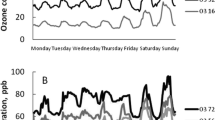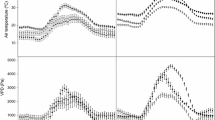Abstract
This study assessed the effect of ambient air pollution on leaf characteristics of white willow, northern red oak, and Scots pine. Willow, oak, and pine saplings were planted at sixteen locations in Belgium, where nitrogen dioxide (NO2), ozone (O3), sulfur dioxide (SO2), and particulate matter (PM10) concentrations were continuously measured. The trees were exposed to ambient air during 6 months (April–September 2010), and, thereafter, specific leaf area (SLA), stomatal resistance (R s), leaf fluctuating asymmetry (FA), drop contact angle (CA), relative chlorophyll content, and chlorophyll fluorescence (F v/F m) were measured. Leaf characteristics of willow, oak, and pine were differently related to the ambient air pollution, indicating a species-dependent response. Willow and pine had a higher SLA at measuring stations with higher NO2 and lower O3 concentrations. Willow had a higher R s and pine had a higher F v/F m at measuring stations with a higher NO2 and lower O3 concentrations, while oak had a higher F v/F m and a lower FA at measuring stations with a higher NO2 and lower O3 concentrations. FA and R s of willow, oak, and pine, SLA of oak, and CA of willow were rather an indicator for local adaptation to the micro-environment than an indicator for the ambient air pollution.


Similar content being viewed by others
References
Adaros, G., Weigel, H. J., & Jager, H. J. (1991). Single and interactive effects of low-levels of O3, SO2 and NO2 on the growth and yield of spring rape. Environmental Pollution, 72, 269–286.
Bagchi, S. K., Sharma, V. P., & Gupta, P. K. (1989). Developmental instability of Tectona grandis. Silvae Genetica, 38, 1–6.
Barber, J. L., Thomas, G. O., Kerstiens, G., & Jones, K. C. (2004). Current issues and uncertainties in the measurement and modeling of air–vegetation exchange and within-plant processing of POPs. Environmental Pollution, 128, 99–138.
Beerling, D. J., & Chaloner, W. G. (1993). The impact of atmospheric CO2 and temperature change on stomatal density: observations from Quercus robur Lammas leaves. Annals of Botany, 71, 231–235.
Bjorksten, T. A., Fowler, K., & Pomiankowski, A. (2000). What does sexual trait FA tell us about stress? Trends in Ecology & Evolution, 15, 163–166.
Bortier, K., Ceulemans, R., & De Temmerman, L. (2000). Effects of ozone exposure on growth and photosynthesis of beech seedlings (Fagus sylvatica). New Phytologist, 2000(146), 271–280.
Brewer, C. A., & Smith, W. K. (1995). Leaf surface wetness and gas-exhange in the pond lily Nuphar polysepalum (Numphaeceae). American Journal of Botany, 82, 1271–1277.
Brewer, C. A., Smith, W. K., & Vogelmann, T. C. (1991). Functional interaction between leaf trichomes, leaf wettability and the optical properties of water droplets. Plant, Cell & Environment, 14, 955–962.
Carreras, H. A., Canas, M. S., & Pignata, M. L. (1996). Differences in responses to urban air pollutants by Ligustrum lucidum Ait. and Ligustrum lucidum Ait. f. tricolor (Rehd.)Rehd. Environmental Pollution, 93, 211–218.
Cowart, N. M., & Graham, J. H. (1999). Within- and among-individual variation in fluctuating asymmetry of leaves in the fig (Ficus carica L.). International Journal of Plant, 160, 116–121.
Dineva, S. B. (2004). Comparative studies of the leaf morphology and structure of white ash Fraxinus americana L. and London plane tree Platanus acerifolila Willd growing in polluted area. Dendrobiology, 52, 3–8.
Dineva, S. B. (2006). Development of the leaf blades of Acer platanoides in industrially contaminated environment. Dendrobiology, 55, 25–32.
Dobbertin, M. (2005). Tree growth as indicator of tree vitality and of tree reaction to environmental stress: a review. European Journal of Forest Research, 124, 319–333.
Eranen, J. K., & Kozlov, M. V. (2006). Physical sheltering and liming improve survival and performance of mountain birch seedlings: a 5-year study in a heavily polluted industrial barren. Restoration Ecology, 14, 77–86.
Flowers, M. D., Fiscus, E. L., Burkey, K. O., Booker, F. L., & Dubois, J. J. B. (2007). Photosynthesis, chlorophyll fluorescence and yield of snap bean (Phaseolus vulgaris L.) genotypes differing in sensitivity to ozone. Environmental and Experimental Botany, 61, 190–198.
Giacomo, B., Forino, L. M. C., Tagliasacchi, A. M., Bernardi, R., & Durante, M. (2010). Ozone damage and tolerance in leaves of two poplar genotypes. Caryologia, 63, 422–434.
Graham, J. H., Shimizu, K., Emlen, J. M., Freeman, D. C., & Merkel, J. (2003). Growth models and the expected distribution of fluctuating asymmetry. Biological Journal of the Linnean Society, 80, 57–65.
Groninger, J. W., Seiler, J. R., Peterson, J. A., Kreh, R. E. (1996). Growth and photosynthetic responses of four Virginia Piedmont tree species to shade. Tree Physiology, 16, 773–778.
Gunn, S., Farrar, J. F., Collis, B. E., & Nason, M. (1999). Specific leaf area in barley: individual leaves versus whole plants. New Phytologist, 143, 45–51.
Hao, Z., & Xiangrong, X. (2006). Leaf developmental instability of Platanus acerifolia under urban environmental stress and its implication as an environmental indicator. Frontiers Biological China, 4, 411–417.
Jäger, H.J., Unsworth, M., De Temmerman, L., Mathy, P. (1992). Effects of air pollution on agricultural crops in Europe. In Proceedings of the final symposium of the European open-top chambers project, 23–25 November 1992, Tervuren, Belgium, pp 281–295.
Knops, J. M. H., & Reinhart, K. (1999). Specific leaf area among a nitrogen fertilization gradient. The American Midland Naturalist, 144, 265–272.
Koch, K., Hartmann, K. D., Schreiber, L., Barthlott, W., & Neinhuis, C. (2006). Influences of air humidity during the cultivation of plants on wax chemical composition, morphology and leaf surface wettability. Environmental and Experimental Botany, 56, 1–9.
Kozlov, M. V., & Niemela, P. (1999). Difference in needle length—a new and objective indicator of pollution impact on Scots pine (Pinus sylvestris). Water, Air, and Soil Pollution, 116, 365–370.
Larcher, W. (2003). Physiological plant ecology: ecophysiology and stress physiology of functional groups. Germany: Springer. 513 p.
Lichtenthaler, H. K., & Babani, F. (2004). Light adaptation and senescence of the photosynthetic apparatus. Changes in pigment composition, chlorophyll fluorescence parameters and photosynthetic activity. In G. C. Papageorgiou & Govindjee (Eds.), Chlorophyll fluorescence: a signature of photosynthesis (pp. 713–736). Dordrecht, The Netherlands: Springer.
Lichtenthaler, H. K., Babani, F., & Langsdorf, G. (2007). Chlorophyll fluorescence imaging of photosynthetic activity in sun and shade leaves of trees. Photosynthetic Research, 93, 235–244.
Loranger, J., & Shipley, B. (2010). Interspecific covariation between stomatal density and other functional leaf traits in a local flora. Botany, 88, 30–38.
Lovett, G., Tear, T. H., Evers, D. C., Findlay, S. E. G., Cosby, B. J., Dunscomb, J. K., Driscoll, C. T., & Weathers, K. C. (2009). Effects of air pollution on ecosystems and biological diversity in the eastern United States. Annals of the New York Academy of Science, 1162, 99–135.
Møller and Swaddle. (1997). Asymmetry, developmental, stability, and evolution. Oxford, Oxford University Press, 305 p.
Moraes, R. M., Furlan, C. M., Bulbovas, P., Domingos, M., Meirelles, S. T., Salatino, A., Delitti, W. B. C., & Sanz, M. J. (2004). Photosynthetic responses of tropical trees to short-term exposure to ozone. Photosynthetica, 42, 291–293.
Murray, F. W. (1967). On the computation of saturation vapor pressure. Journal of Applied Meteorology, 6, 203–204.
Nighat, F., & Iqbal, M. (2000). Stomatal conductance, photosynthetic rate, and pigment content in Ruellia tuberosa leaves as affected by coal-smoke pollution. Biological Plantarum, 43, 263–267.
Palmer, A. R., & Strobeck, C. (1986). Fluctuating asymmetry: measurement, analysis, patterns. Annual Review of Ecological Systems, 17, 391–421.
Pandey, S., & Nagar, P. K. (2002). Leaf surface wetness and morphological characteristics of Valeriana jatamansi grown under open and shade habitats. Biologica Plantarum, 45, 291–294.
Papageorgiou, G.C., Govindjee. (2004). Chlorophyll a fluorescence: a signature of photosynthesis. The Netherlands, Springer, Advances in photosynthesis and respiration, volume 19, 795 p
Percy, K. E., Jensen, K. F., & McQuattie, C. J. (1992). Effects of ozone and acidic fog on red spruce needle epicuticular wax production, chemical composition, cuticular membrane ultrastructure and needle wettability. New Phytologist, 122, 71–80.
Pinheiro, K., Bates, D. DebRoy, S., Sarkar, D., the R Core team, (2009). nlme: linear and nonlinear mixed effects models. R package version 3.1–96.
Poorter, H., Niinemets, U., Poorter, L., Wright, I. J., & Villar, R. (2009). Transley review. Causes and consequences of variation in leaf mass area (LMA): a meta-analysis. New Phytologist, 182, 565–588.
Reed, S., Schnell, R., Moore, J. M., & Dunn, C. (2012). Chlorophyll a + b content and chlorophyll fluorescence in avocado. Journal of Agricultural Science, 4, 29–36.
Robinson, M. F., Heath, J., & Mansfield, T. A. (1998). Disturbances in stomatal behaviour caused by air pollutants. Journal of Experimental Botany, 49, 461–469.
Sarijeva, G., Knapp, M., & Lichtenthaler, H. K. (2007). Differences in photosynthetic activity, chlorophyll and carotenoid levels, and in chlorophyll fluorescence parameters in green sun and shade leaves of Ginkgo and Fagus. Journal of Plant Physiology, 164, 950–955.
Schenone, G., Fumagalli, I., Mignanego, L., Montinaro, F., & Soldatini, G. F. (1994). Effects of ambient air pollution in open-top chambers on bean (Phaseolus vulgaris L.). II. Effects on photosynthesis and stomatal conductance. New Phytologist, 126, 309–315.
Sellin, A. (2000). Estimating the needle area from geometric measurements: application of different calculation methods to Norway spruce. Trees, 14, 215–222.
Valladares, F., Chica, J. M., Aranda, I., Balaguer, L., Dizengremel, P., Manrique, E., & Dreyer, E. (2002). The greater seedling high-light tolerance of Quercus robur over Fagus sylvatica is linked to a greater physiological plasticity. Trees, 16, 395–403.
Van Hees, A. F. M., & Clerkx, A. P. P. M. (2003). Shading and root–shoot relations in saplings of silver birch, pedunculate oak and beech. Forest Ecology and Management, 176, 439–448.
van Hove, L. W. A., van Kooten, O., Adema, E. H., Vredenburg, W. J., & Pieters, G. A. (1989). Physiological effects of long-term exposure to low and moderate concentrations of atmospheric NH3 on poplar leaves. Plant, Cell & Environment, 12, 899–908.
Wuytack, T., Verheyen, K., Wuyts, K., Kardel, F., Adriaenssens, S., & Samson, R. (2010). The potential of biomonitoring of air quality using leaf characteristics of white willow (Salix alba L.). Environmental Monitoring and Assessment, 171, 197–204.
Wuytack, T., Wuyts, K., Van Dongen, S., Baeten, L., Kardel, F., Verheyen, K., & Samson, R. (2011). The effect of air pollution and other environmental stressors on leaf fluctuating asymmetry and specific leaf area of Salix alba L. Environmental Pollution, 159, 2405–2411.
Zuur, A. F., Ieno, E. N., Walker, N. J., Saveliev, A. A., & Smith, G. M. (2009). Mixed effect models and extensions in ecology with R. New York: Springer. 575 p.
Acknowledgments
We would like to thank VMM, ISSeP, and BIM, which allowed entrance to the measuring stations and provided us with the necessary air pollution data. Also, many thanks to Jeroen Wyffels for the assistance in the fieldwork and Roland Caubergs for making the samples for anatomical studies. This research was funded by a PhD grant of the Agency for Innovation through Science and Technology (IWT-Vlaanderen).
Author information
Authors and Affiliations
Corresponding author
Rights and permissions
About this article
Cite this article
Wuytack, T., Samson, R., Wuyts, K. et al. Do Leaf Characteristics of White Willow (Salix alba L.), Northern Red Oak (Quercus rubra L.), and Scots Pine (Pinus sylvestris L.) Respond Differently to Ambient Air Pollution and Other Environmental Stressors?. Water Air Soil Pollut 224, 1635 (2013). https://doi.org/10.1007/s11270-013-1635-9
Received:
Accepted:
Published:
DOI: https://doi.org/10.1007/s11270-013-1635-9




